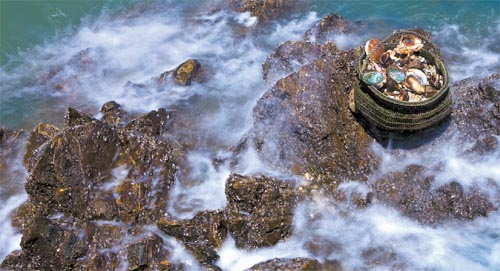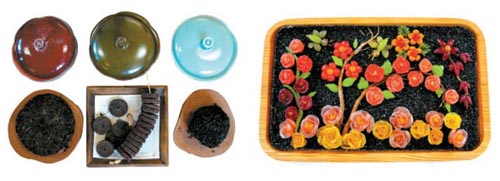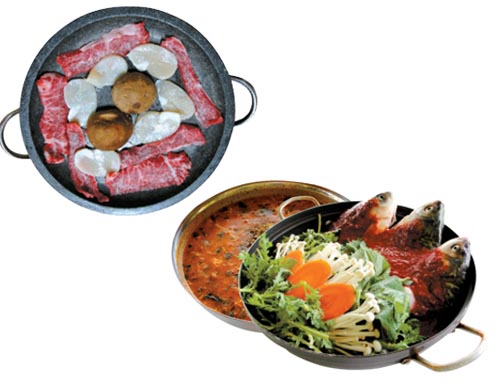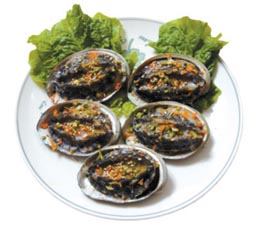Taste the slow life with these Korean food specialties

Fresh abalone from Cheongsan Island, HOTEL EVENTS which is one of six designated slow cities in Korea. By Kwen Hyek-jae
“Abalones move from rock to rock and live on seaweed. So it is only natural that if the things abalones eat are clean and natural, the abalones are as well,” Go said pointing to the water. “Look at this water, it is emerald colored.”
On our ship, the Sinae, a two-hour-long talk on abalone and food followed. The divers started off at 7:00 in the morning to catch abalone but had been looking for two hours for a spot in the sea with calm waves. At around 9:00, our ship found a spot to settle at, where the haenyeo jumped into the water like dolphins. The abalones they found were fresh and smelled of the clean sea.
Cheongsan Island is one of the six designated slow cities in Korea. The slow city movement, officially called Cittaslow, originates from Italy. In the Cittaslow movement, towns adapt a slower lifestyle to live in harmony with their natural surroundings.
The movement has grown on an international scale and is gaining more attention by the day. Tomorrow will see the start of the 2010 International Cittaslow Assembly of Corea Invitational, a general assembly of Korean slow cities that has been held annually since 2008. This year, the meeting will take place at the Seoul Museum of History.
I left on a trip to discover “slow” food in Korea’s designated slow cities. The types of food I mention are representative of the foods grown or found in these regions. Contrary to the theme of the trip, it was a hectic journey around six cities in just four days. Despite my jam-packed schedule, however, encountering fresh, “slow” food made my attitude toward the schedule a bit more forgiving.
By Lee Sang-eun [jainnie@joongang.co.kr]

Left: Tteokcha from Agyang, Hadong County, South Gyeongsang / Right: Hangwa, a traditional Korean dessert, made by Park Sun-ae, another “master” designated by the agriculture ministry.
Agyang, Hadong County, South Gyeongsang
Hadong is the first place in Korea to have started planting tea. The town of Agyang in Hadong was designated the first slow city in the world with a tea plantation area. Surrounded by Mout Jiri’s Seongjae and Chilseong peaks, the town is protected from excessive wind and is relatively warm during the winter, making it a great spot for tea cultivation.
There we found Maeam Dawon, a tea museum complete with a tea cafe. For only 2,000 won ($1.70), you can order a cup of tea and enjoy the view from the garden.
“We grow our tea trees without using any pesticides or chemical fertilizers. All the tea is grown organically,” said Gang Dong-oh, 43, head of the museum. Gang added that one of the prize tea varieties that came from this town is a fermented tea called tteokcha. To make it, the tea leaves are steamed, ground and then fermented for three to five years. Although fermented tea doesn’t have the crispness of non-fermented teas, it has a deeper, subtler flavor.
Maeam Dawon: Jeongseo-ri, Agyang-myeon, Hadong, South Gyeongsang 293, (055) 883-3500
Changpyeong, Damyang County, South Jeolla

Soy sauce made by Ki Soon-do, who has earned the designation of master from the agriculture ministry
“I look after this soy sauce as if it were one of my children,” she said.
For Ki, the most important elements for quality soy sauce are the water and salt used. She said that she only uses bamboo salt from Damyang bamboo trees as well as natural bedrock water from 150 meters (492 feet) below the sea in Changpyeong.
Another Changpyeong native with the title of master is Yu Yeong-gun, 61, who is recognized for his rice taffy. Surprisingly, his taffy, made only with rice and taffy oil, doesn’t stick to your teeth and has a crispy texture.
The last master we met in the town is Park Sun-ae, 54, who makes traditional Korean desserts using rice. First, she puts rice in water and leaves it for a week, and then she steams and grinds the rice, adding grain syrup and natural food coloring.
Market for Ki’s soy sauce: Yucheon, Changpyeong-myeon, Damyang County, South Jeolla 181-7, (061) 383-6209
Market for Yu’s rice taffy: Samcheon, Changpyeong-myeon, Damyang County, South Jeolla 35-1, (061) 383-6446
Market for Park’s desserts: Samcheon, Changpyeong-myeon, Damyang County, South Jeolla 180-1, (061) 383-8283

Left: A dish made of mushrooms, mussels and beef from Yuchi, Jangheung County, South Jeolla / Right: Eojuk and bungeojjim from Daeheung, Yesan County, South Chungcheong
Yuchi, Jangheung County, South Jeolla
In Yuchi, shiitake mushrooms live hidden in the town’s scenic mushroom plantation, with the Jangheung dam in the front and Gaji Mountain behind. Only the sound of birds and flowing water can be heard where the mushrooms are grown. Like at Hadong, the mushrooms in Yuchi are grown organically. The town’s most famous dish incorporates these mushrooms, beef and fan mussels. The ingredients are grilled and eaten together.
The mushroom, beef and mussel dish can be found at Myeongheenae Restaurant in Yeyang-ri, Jangheung, South Jeolla 158-1, (061) 862-3329.
Daeheung, Yesan County, South Chungcheong
Daeheung is the home of Yedang Reservoir, the biggest freshwater lake in the nation. The reservoir’s clean, fresh water makes the town famous for its bungeojjim (steamed carp) and eojuk (fish porridge). We walked into Yedang Garden, one of the more famous fish restaurants in the area.
“We throw out a fishing net around 7 p.m. every day and we catch a lot of carp in the net by the next morning. We use freshly caught fish in our cooking,” said Yun Gi-ja, the owner of the restaurant. Yun added that they also cultivate their own vegetables. The bungeojjim, which is made by boiling a fresh carp with white radish, green onion, garlic and red pepper paste, had a very smooth texture and a spicy and tangy taste. The eojuk, which was also highly nutritious, was made with carp, eel, fresh water shrimp and was boiled for three hours with highly valuable medicinal herbs. It had a rich, full-bodied flavor.
Yedang Garden: Nodong-ri, Daeheung-myeon, Yesan, South Chungcheong 81-2, (041) 333-4473
Cheongsan Island, Wando Islands, South Jeolla

Steamed abalone from Cheongsan Island, Wando Islands, South Jeolla
Seommaeul Restaurant (061-552-8672) serves abalone shabu-shabu, as well as seasoned abalone and steamed abalone. The abalone shabu-shabu intensifies the rich flavor unique to abalone, and seasoned abalone is spicy and sour at the same time. The steamed abalone has a soft texture and a clean taste.
For fresh abalone, contact Jeonbok Nara (061) 552-8870. For farmed abalone, contact Hanbada Susan (061) 554-5035.
Jeung Island, Sinan, South Jeolla
Jeung Island is famous for its sun-dried salt. According to Jung Yeong-jin, an officer at Jeung Island Slow City, the place was designated by Unesco as a Wetland Reserve and its mudflat has a copious amount of minerals. As a result, the salt itself also has an abundance of healthy minerals.
“We are confident about the quality of our salt. It is comparable to the gray sea salt from the Guerande region in France,” Jung added.
We tasted the salt crystals at the salt farm and surprisingly, it tasted salty at first but a subtle sweetness followed. It was not bitter at all.
Salt is not the only slow food that has made Jeung Island famous, however. Clam soup is the dish most recommend by Jeung Islanders. We visited Gaetmaeul Restaurant, which is famous for its clam soup. There, the clams and leeks are boiled together without any seasoning.
Jeung Island salt is available for purchase through Taepyeong Salt Farm, Daecho-ri, Jeungdo-myeon, Sinan County, South Jeolla 1650-37, (061) 275-0370.










with the Korea JoongAng Daily
To write comments, please log in to one of the accounts.
Standards Board Policy (0/250자)